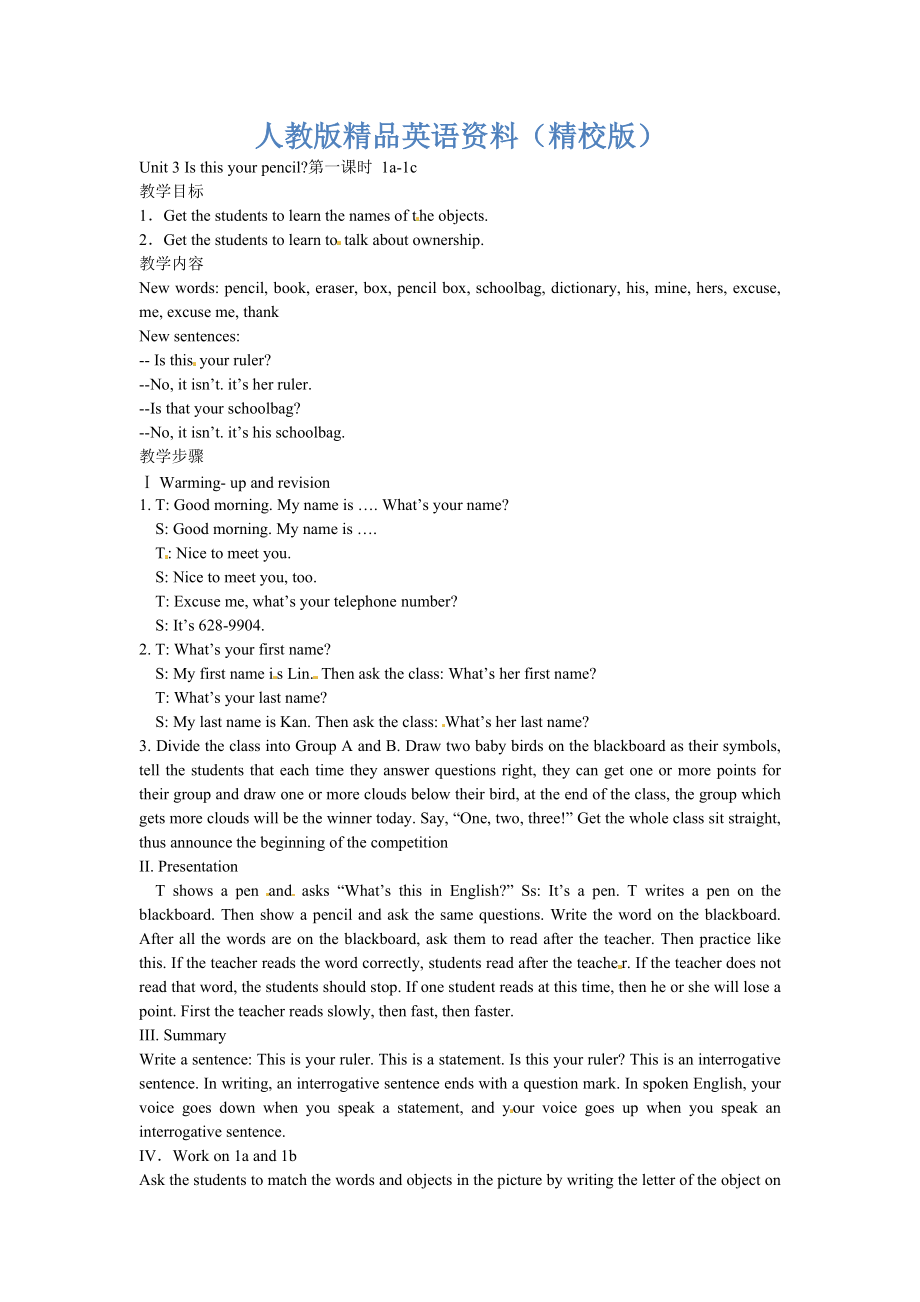《【精校版】Unit 3 Is this your pencil第一課時(shí) 1a1c》由會(huì)員分享���,可在線閱讀�����,更多相關(guān)《【精校版】Unit 3 Is this your pencil第一課時(shí) 1a1c(2頁珍藏版)》請(qǐng)?jiān)谘b配圖網(wǎng)上搜索�����。
1����、人教版精品英語資料(精校版)
Unit 3 Is this your pencil?第一課時(shí) 1a-1c
教學(xué)目標(biāo)
1.Get the students to learn the names of the objects.
2.Get the students to learn to talk about ownership.
教學(xué)內(nèi)容
New words: pencil, book, eraser, box, pencil box, schoolbag, dictionary, his, mine, hers, excuse, me, excuse me, thank
New
2、sentences:
-- Is this your ruler?
--No, it isn’t. it’s her ruler.
--Is that your schoolbag? [來源:數(shù)理化網(wǎng)]
--No, it isn’t. it’s his schoolbag.
教學(xué)步驟
Ⅰ Warming- up and revision [來源:]
1. T: Good morning. My name is …. What’s your name?
S: Good morning. My name is ….
T: Nice to meet you.
S: Nice
3���、 to meet you, too.
T: Excuse me, what’s your telephone number?
S: It’s 628-9904.
2. T: What’s your first name?
S: My first name is Lin. Then ask the class: What’s her first name?[來源:]
T: What’s your last name?
S: My last name is Kan. Then ask the class: What’s her last name?
3. Div
4�、ide the class into Group A and B. Draw two baby birds on the blackboard as their symbols, tell the students that each time they answer questions right, they can get one or more points for their group and draw one or more clouds below their bird, at the end of the class, the group which gets more clo
5�、uds will be the winner today. Say, “One, two, three!” Get the whole class sit straight, thus announce the beginning of the competition
II. Presentation
T shows a pen and asks “What’s this in English?” Ss: It’s a pen. T writes a pen on the blackboard. Then show a pencil and ask the same questions.
6、Write the word on the blackboard. After all the words are on the blackboard, ask them to read after the teacher. Then practice like this. If the teacher reads the word correctly, students read after the teacher. If the teacher does not read that word, the students should stop. If one student reads a
7��、t this time, then he or she will lose a point. First the teacher reads slowly, then fast, then faster.
III. Summary
Write a sentence: This is your ruler. This is a statement. Is this your ruler? This is an interrogative sentence. In writing, an interrogative sentence ends with a question mark. In
8��、 spoken English, your voice goes down when you speak a statement, and your voice goes up when you speak an interrogative sentence.
IV.Work on 1a and 1b
Ask the students to match the words and objects in the picture by writing the letter of the object on the blank line after the word. Focus attent
9��、ion on each of the three conversations. Ask students to identify the objects the person in each conversation is holding or pointing to.(A boy is holding a pencil, a girl is holding a ruler, and the teacher is pointing to a schoolbag.)
Then Play the recording the first time. Students only listen. Po
10、int out the boxes where students will write a number in the box to each conversation.
V.Work on 1c
1. Get the students to listen again repeat each conversation. Pay attention to the falling and rising tones in each conversation.
2. point to the book in the main illustration and substitute boo
11�、k into one of the conversations. Ask students to practice the conversation in pairs. Remind them to use various objects from the main illustration. The teacher checks the progress and pronunciation.
VI.Work on 2a and 2b
Point to the objects in the illustration and ask students to name each one. P
12����、lay the recording the first time. Students only listen. Play the recording a second time. This time students put a checkmark in the blank after each item whose name is mentioned in the conversation. Then ask students to point to the blank lines in the conversation. Say, You will write one of the wor
13、ds from the box on each blank line.
Now let’s listen to the tape and repeat. Please try to recite the conversation like the tape. Practice. First imitate then fill in the blanks.
VII. Homework
Listen and read after the tape for thirty minutes.
Recite the converstaion of Section A, 2b.[來源:]
Write down the Chinese meaning of the new words and key sentences, then translate them into English.
 【精校版】Unit 3 Is this your pencil第一課時(shí) 1a1c
【精校版】Unit 3 Is this your pencil第一課時(shí) 1a1c

